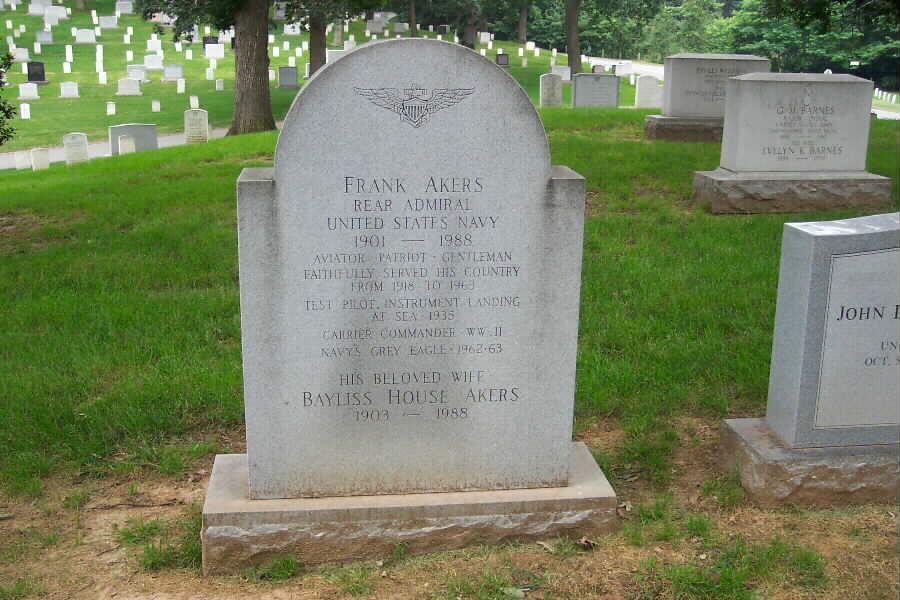1901-1988. His stone in Section 30 of Arlington National Cemetery reads:
“Aviator, patriot, gentleman. Faithfully served his country from 1918 to 1963. Test pilot, instrument landing at sea, 1935. Carrier commander, World War II. The Navy’s Grey Eagle.”
His wife, Bayless House Akers (1903-1988) is buried with him.
MAY 1, 1934
Lieutenant Frank Akers made a hooded landing in an OJ-2 at College Park, Maryland, in the first demonstration of the blind landing system intended for carrier use and under development by the Washington Institute of Technology.
Rear Admiral Akers was commissioned an Ensign in the Class of 1922. He was assigned to the USS Sumner which operated in the Pacific Ocean. The following year, as the Engineering Officer of this destroyer, he won the “E” for Engineering Excellence and was commended by the Secretary of the Navy.
On September 11, 1925, he received the Navy “Wings of Gold”. As a naval aviator, he was ordered to an aircraft squadron with the Battle Fleet. In 1928, he returned to Pensacola, Florida, as Instructor in Command of all Fighter Training.
In 1931, Lieutenant Frank Akers, was a student of electronics at the Postgraduate School in Annapolis, Maryland. He continued studying at Harvard Graduate School in Cambridge, Massachusetts. It was here that he received his Master of Science Degree in Electronic Communications in 1933.
As Flight Test Officer and Project Officer for Instrument Flying Development at the Naval Air Station in San Diego, California, Lieutenant Akers participated in an unusually hazardous experiment on July 30, 1935. He was told that the nation’s first aircraft carrier, the USS Langley, was somewhere at sea approximately 150 miles away. It was his job to locate the carrier and land aboard it using only instruments. The aircraft was fitted with a special hood preventing visual contact with the outside world. He chalked up another Navy “first” when the plane touched down on the carrier deck and caught the Number 4 arresting wire. This was a feat that earned him the distinguished Flying Cross.
During 1942, he served as Navigator of the USS Hornet. He participated in the famed Doolittle Raid on Tokyo and the Battle of the Midway. Later, back in Washington as head of the Radio and Electrical Branch of the Bureau of
Aeronautics, he received the Legion of Merit for his part in developing more efficient and simplified aircraft electronic systems, including radar bombing.
As Commanding Officer of the USS Saratoga in 1945-1946, he amassed a new world’s record – 642 carrier landing in a single day. Upon completion of the Pacific War, the Saratoga returned more men to the United States than any other
ship.
In keeping with the unique and varied career of Rear Admiral Akers, he has commanded aircraft carrier divisions in both the Atlantic and Pacific Fleets. He is the only aviator ever to have been assigned as Assistant Chief of Naval
Operations for Undersea Warfare. In addition, he commanded the Naval Air Technical Training Command in Memphis, Tennessee, and served as senior Naval Member of the Weapons System Evaluations Board in the Pentagon.
On January 11, 1962, at the Hotel Del Coronado in San Diego, California, Rear Admiral Akers was presented the Gray Eagle Trophy honoring him as the Naval Aviator who has been flying longer than any other on active duty. Rear Admiral Akers’ son had an excellent quote about his father: “His life was built on the pursuit of excellence, coupled with a fierce determination to be the very best at anything, big or small. He was always a fine gentlemen who respected others.”
Michael Robert Patterson was born in Arlington and is the son of a former officer of the US Army. So it was no wonder that sooner or later his interests drew him to American history and especially to American military history. Many of his articles can be found on renowned portals like the New York Times, Washingtonpost or Wikipedia.
Reviewed by: Michael Howard

